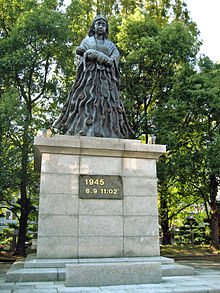- Nagasaki Peace Park
-
Nagasaki Peace Park is a park located in Nagasaki, Japan, commemorating the atomic bombing of the city on August 9, 1945 during World War II.
Contents
History
Established in 1955, and near to the hypocentre of the explosion, remnants of a concrete wall of Urakami Cathedral can still be seen. Urakami Cathedral was the grandest church in east Asia at the time. At the park's north end is the 10-meter-tall Peace Statue created by sculptor Seibou Kitamura of Nagasaki Prefecture. The statue's right hand points to the threat of nuclear weapons while the extended left hand symbolizes eternal peace. The mild face symbolizes divine grace and the gently closed eyes offer a prayer for the repose of the bomb victims' souls. The folded right leg and extended left leg signify both meditation and the initiative to stand up and rescue the people of the world. Installed in front of the statue is a black marble vault containing the names of the atomic bomb victims and survivors who died in subsequent years.
Plaque
A plaque at the nearby hypocentre gives the following account and statistics of the damage caused that day.
“ At 11:02 A.M., August 9, 1945 an atomic bomb exploded 500 meters above this spot. The black stone monolith marks the hypocenter.
The fierce blast wind, heat rays reaching several thousand degrees and deadly radiation generated by the explosion crushed, burned, and killed everything in sight and reduced this entire area to a barren field of rubble.
About one-third of Nagasaki City was destroyed and 150,000 people killed or injured and it was said at the time that this area would be devoid of vegetation for 75 years. Now, the hypocenter remains as an international peace park and a symbol of the aspiration for world harmony.” DAMAGE CAUSED BY THE ATOMIC BOMB EXPLOSION 1. Leveled Area: 6.7 million square meters (2.59 square miles) 2. Damaged Houses: Completely burned: 11,574 Completely destroyed: 1,326 Badly damaged: 5,509 Total structures damaged: 18,409 3. Casualties: Killed: 73,884 Injured: 74,909 Total: 148,793 (Large numbers of people have died in the following years from the effects of radioactive poisoning)
Peace Memorial Ceremony
Every year, on 9 August, the anniversary of the atomic bombing, a Peace Memorial Ceremony is held in front of the statue and the Mayor of Nagasaki delivers a Peace Declaration to the World.[1]
At the south end of the park is a "Fountain of Peace". This was constructed in August, 1969, as a prayer for the repose of the souls of the many atomic bomb victims who died searching for water, and as a dedication to world peace. Lines from a poem by a girl named Sachiko Yamaguchi, who was nine at the time of the bombing, are carved on a black stone plaque in front of the fountain. It reads: "I was thirsty beyond endurance. There was something oily on the surface of the water, but I wanted water so badly that I drank it just as it was."
Peace Symbols Zone
 "Memorial at hypocenter" in front of the hypocenter to mark the date and time of the historic bomb explosion in Nagasaki
"Memorial at hypocenter" in front of the hypocenter to mark the date and time of the historic bomb explosion in Nagasaki
In 1978 the city of Nagasaki established a "Peace Symbols Zone" on both sides of the park and invited donations of monuments from countries round the world. The following monuments can be seen in the park:
- "Relief of Friendship" from Porto, Portugal (Nagasaki's sister city), 1978
- "Joy of Life" from Czechoslovakia, (donated to Nagasaki in 1980). The bronze statue 260 cm in height was made by Czech sculptor Jan Hána (1927–1994) in 1975.[2]
- "A Call" from Bulgaria, 1980
- "Monument of People's Friendship" from the former German Democratic Republic, 1981
- "Protection of Our Future" from the city of Middelburg, The Netherlands (Nagasaki's sister city), 1983
- "Statue of Peace" from the former Union of Soviet Socialist Republics, 1985
- "Maiden of Peace" from the People's Republic of China, 1985
- "Flower of Love and Peace" from Poland, 1986
- "Hymn to Life" from the City of Pistoia,Italy, 1987
- "Sun Crane of Peace" from the Republic of Cuba, 1988
- "Monument of Peace" from Santos, Brazil (Nagasaki's sister city), 1988
- "Infinity" from Ankara, Republic of Turkey, 1991
- "Constellation Earth" from St. Paul, Minnesota, USA (Nagasaki's sister city), 1992
- "Triumph of Peace over War" from the City of San Isidro[disambiguation needed
 ], Argentina, 1996
], Argentina, 1996 - "Te Korowai Rangimarie - Cloak of Peace" from New Zealand, 2006.
References
- ^ Nagasaki Places of Interest: Peace Park
- ^ Joy of Life (1975) http://www.janhana.com/statues/joy-of-life/ accessed 28 January 2009
External links
Coordinates: 32°46′32″N 129°51′47″E / 32.77558°N 129.86312°E
Categories:- Nagasaki
- Atomic bombings of Hiroshima and Nagasaki
- Monuments and memorials in Japan
- Parks in Japan
- Parks and gardens in Nagasaki
- Peace parks
- Peace symbols
- Peace
- Monuments associated with the atomic bombings of Hiroshima and Nagasaki
Wikimedia Foundation. 2010.




